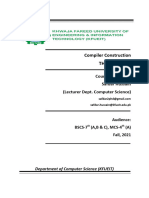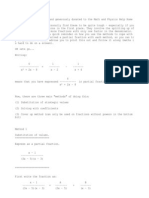50%(2)50% found this document useful (2 votes)
373 viewsQuick Sort: - It Is An Algorithm of Divide and Conquer
Quick Sort is an algorithm that uses divide and conquer to sort a list by picking a pivot element and partitioning the list into two sublists based on whether elements are less than or greater than the pivot, and then recursively applying the same approach to the sublists; the algorithm involves pushing boundary values of sublists onto a stack and popping them off to recursively apply the partitioning.
Uploaded by
Kumar VidyaCopyright
© © All Rights Reserved
Available Formats
Download as PPT, PDF, TXT or read online on Scribd
50%(2)50% found this document useful (2 votes)
373 viewsQuick Sort: - It Is An Algorithm of Divide and Conquer
Quick Sort is an algorithm that uses divide and conquer to sort a list by picking a pivot element and partitioning the list into two sublists based on whether elements are less than or greater than the pivot, and then recursively applying the same approach to the sublists; the algorithm involves pushing boundary values of sublists onto a stack and popping them off to recursively apply the partitioning.
Uploaded by
Kumar VidyaCopyright
© © All Rights Reserved
Available Formats
Download as PPT, PDF, TXT or read online on Scribd
You are on page 1/ 6
Quick Sort
• It is an algorithm of divide and conquer.
44, 33, 11, 55, 77, 90, 40, 60, 99, 22, 88, 66
• After reduction step, final position of no. is:
22, 33, 11, 40, 44, 90, 77, 60, 99, 55, 88, 66
First sublist Second sublist
• The algorithm begins by pushing boundary values 1 and 12 onto stack to
yield
Lower: 1 Upper: 12
• To apply reduction step, top values are removed from stack, leaving
Lower: (empty) Upper: (empty)
• And then reduction step is applied to list from A[1] to A[12]. Finally 44
reaches its final location A[5].
• Accordingly, algo. Pushes boundary values 1 and 4 to 1 st sublist and 6 and
12 to 2nd sublist onto stack, leaving
Lower: 1, 6 Upper: 4, 12
• Now, apply reduction step again by removing top values from stack,
leaving
Lower: 1 Upper: 4
• Then reduction step is applied to sublist A[6] to A[12], and so on.
Lower: 1, 6 Upper: 4, 10
Quick sort algorithm
QUICK(A, N, BEG, END, LOC)
1. [Initialize] Set LEFT = BEG, RIGHT=END, LOC=BEG
2. [Scan from right to left]
a. Repeat while A[LOC] <=A[RIGHT] and LOC != RIGHT
i. RIGHT = RIGHT-1
b. If LOC = RIGHT then return
c. If A[LOC] > A[RIGHT] then
i. [Interchange A[LOC] and A[RIGHT] ] Temp = A[LOC], A[LOC] =
A[RIGHT], A[RIGHT] = Temp
ii. Set LOC = RIGHT
iii. Go to step 3.
3. [Scan from left to right]
a. Repeat while A[LEFT] <=A[LOC] and LEFT != LOC
i. LEFT = LEFT+1
b. If LOC = LEFT then return
c. If A[LEFT] > A[LOC] then
i. [Interchange A[LEFT] and A[LOC] ] Temp = A[LOC], A[LOC] = A[LEFT],
A[LEFT] = Temp
ii. Set LOC = LEFT
iii. Go to step 2.
Quick sort algorithm
QUICKSORT()
1. [Initialize] TOP = NULL
2. [Push boundary value of A onto stacks when A has 2 or more elements]
If N >1 then TOP = TOP + 1, LOWER[1] = 1, UPPER[1] = N
3. Repeat steps 4 to 7 while TOP != NULL
4. [Pop sublist from stacks]
Set BEG = LOWER[TOP] , END = UPPER[TOP]
TOP = TOP – 1
5. Call QUICK(A, N, BEG, END, LOC)
6. [ Push left sublist onto stacks when it has 2 or more elements]
If BEG < LOC-1 then
TOP = TOP + 1, LOWER[TOP] = BEG, UPPER[TOP] = LOC-1
7. [ Push right sublist onto stacks when it has 2 or more elements]
If LOC+1 < END then
TOP = TOP+1, LOWER[TOP] = LOC + 1, UPPER[TOP] = END
8. Exit.
Tower of Hanoi
Algorithm
Tower (N, Beg, Aux, End)
1. If N = 1, then
a) Write BegEnd
b) Return
2. // [Move N-1 disks from Beg to Aux]
Call Tower (N-1, Beg, End, Aux)
3. Write BegEnd
4. // [Move N-1 disks from Aux to End]
Call Tower (N-1, Aux, Beg, End)
7. Return
You might also like
- Errata For Digital Signal Processing A Computer Based Approach 4th Edition by Sanjit MitraNo ratings yetErrata For Digital Signal Processing A Computer Based Approach 4th Edition by Sanjit Mitra8 pages
- 1 University of Okara Assignment Submitted Subject-2No ratings yet1 University of Okara Assignment Submitted Subject-24 pages
- Match The Numbers: Hindi Numeral Number Number NamesNo ratings yetMatch The Numbers: Hindi Numeral Number Number Names1 page
- COSC - 3104 - Compiler Construction, 16-Weeks Plan Course Outline100% (1)COSC - 3104 - Compiler Construction, 16-Weeks Plan Course Outline6 pages
- Ideal and Practical Filters: 308201-Communication Systems 34No ratings yetIdeal and Practical Filters: 308201-Communication Systems 349 pages
- Lecture On Database by Miss Aysha (GCUF)No ratings yetLecture On Database by Miss Aysha (GCUF)6 pages
- Digital Signal Processing by Ramesh BabuNo ratings yetDigital Signal Processing by Ramesh Babu305 pages
- Data Structure Fundamentals - Md. Rafiqul Islam and M. A. MottalibNo ratings yetData Structure Fundamentals - Md. Rafiqul Islam and M. A. Mottalib167 pages
- Theory of Automata (CS402) Assignment No.1 Solution: Question No.1 Recursive DefinitionNo ratings yetTheory of Automata (CS402) Assignment No.1 Solution: Question No.1 Recursive Definition5 pages
- Permutation & Combination and Probability)No ratings yetPermutation & Combination and Probability)11 pages
- CS 510-Design and Analysis of Algorithms-Imdad Ullah KhanNo ratings yetCS 510-Design and Analysis of Algorithms-Imdad Ullah Khan3 pages
- PESIT Bangalore South Campus: Internal Assessment Test Ii-SolutionNo ratings yetPESIT Bangalore South Campus: Internal Assessment Test Ii-Solution8 pages
- Backtracking and Branch and Bound FinalNo ratings yetBacktracking and Branch and Bound Final63 pages
- Lab Experiment # 8: Implementation and Verification of Truth Tables of Logic Gates (AND, OR, NOT, NOR, NAND) On TrainerNo ratings yetLab Experiment # 8: Implementation and Verification of Truth Tables of Logic Gates (AND, OR, NOT, NOR, NAND) On Trainer7 pages
- Introduction To Digital System. Evolution of Digital SystemNo ratings yetIntroduction To Digital System. Evolution of Digital System9 pages
- CFG - Derivation - Parse Tree - Removing AmbiguityNo ratings yetCFG - Derivation - Parse Tree - Removing Ambiguity27 pages
- CS2011 - Fundamentals OF Database Systems: National University OF Computer & Emerging Sciences, Fast-NuNo ratings yetCS2011 - Fundamentals OF Database Systems: National University OF Computer & Emerging Sciences, Fast-Nu2 pages
- Theory of Computation BSC CSIT Old QuestionsNo ratings yetTheory of Computation BSC CSIT Old Questions7 pages
- How Does Quicksort Work?: Conquer CombineNo ratings yetHow Does Quicksort Work?: Conquer Combine10 pages
- Data Structures and Algorithms: SortingNo ratings yetData Structures and Algorithms: Sorting44 pages
- Drying Wet Framing JLC June 2013 ArticleNo ratings yetDrying Wet Framing JLC June 2013 Article5 pages
- CIAC Arbitration EO 1008 Ceniza Lecture - 38 PagesNo ratings yetCIAC Arbitration EO 1008 Ceniza Lecture - 38 Pages38 pages
- Somatic RET Indels in Sporadic Medullary Thyroid CancerNo ratings yetSomatic RET Indels in Sporadic Medullary Thyroid Cancer8 pages
- 14 1 22 Engineering Datasheet Rse75n A13 RevcNo ratings yet14 1 22 Engineering Datasheet Rse75n A13 Revc1 page
- IEPE (Integrated Electronics Piezo-Electric) - KistlerNo ratings yetIEPE (Integrated Electronics Piezo-Electric) - Kistler2 pages
- Lindsay Anton - The Final Paper - 2956488No ratings yetLindsay Anton - The Final Paper - 295648821 pages
- Byte Con Fiden Tial Don Otc Opy: Model Name: Ga-H110M-S2HNo ratings yetByte Con Fiden Tial Don Otc Opy: Model Name: Ga-H110M-S2H50 pages
- Errata For Digital Signal Processing A Computer Based Approach 4th Edition by Sanjit MitraErrata For Digital Signal Processing A Computer Based Approach 4th Edition by Sanjit Mitra
- 1 University of Okara Assignment Submitted Subject-21 University of Okara Assignment Submitted Subject-2
- Match The Numbers: Hindi Numeral Number Number NamesMatch The Numbers: Hindi Numeral Number Number Names
- COSC - 3104 - Compiler Construction, 16-Weeks Plan Course OutlineCOSC - 3104 - Compiler Construction, 16-Weeks Plan Course Outline
- Ideal and Practical Filters: 308201-Communication Systems 34Ideal and Practical Filters: 308201-Communication Systems 34
- Data Structure Fundamentals - Md. Rafiqul Islam and M. A. MottalibData Structure Fundamentals - Md. Rafiqul Islam and M. A. Mottalib
- Theory of Automata (CS402) Assignment No.1 Solution: Question No.1 Recursive DefinitionTheory of Automata (CS402) Assignment No.1 Solution: Question No.1 Recursive Definition
- CS 510-Design and Analysis of Algorithms-Imdad Ullah KhanCS 510-Design and Analysis of Algorithms-Imdad Ullah Khan
- PESIT Bangalore South Campus: Internal Assessment Test Ii-SolutionPESIT Bangalore South Campus: Internal Assessment Test Ii-Solution
- Lab Experiment # 8: Implementation and Verification of Truth Tables of Logic Gates (AND, OR, NOT, NOR, NAND) On TrainerLab Experiment # 8: Implementation and Verification of Truth Tables of Logic Gates (AND, OR, NOT, NOR, NAND) On Trainer
- Introduction To Digital System. Evolution of Digital SystemIntroduction To Digital System. Evolution of Digital System
- CFG - Derivation - Parse Tree - Removing AmbiguityCFG - Derivation - Parse Tree - Removing Ambiguity
- CS2011 - Fundamentals OF Database Systems: National University OF Computer & Emerging Sciences, Fast-NuCS2011 - Fundamentals OF Database Systems: National University OF Computer & Emerging Sciences, Fast-Nu
- CIAC Arbitration EO 1008 Ceniza Lecture - 38 PagesCIAC Arbitration EO 1008 Ceniza Lecture - 38 Pages
- Somatic RET Indels in Sporadic Medullary Thyroid CancerSomatic RET Indels in Sporadic Medullary Thyroid Cancer
- IEPE (Integrated Electronics Piezo-Electric) - KistlerIEPE (Integrated Electronics Piezo-Electric) - Kistler
- Byte Con Fiden Tial Don Otc Opy: Model Name: Ga-H110M-S2HByte Con Fiden Tial Don Otc Opy: Model Name: Ga-H110M-S2H

























































































